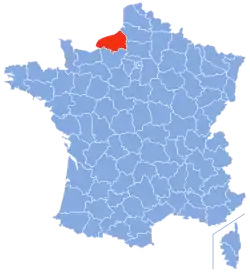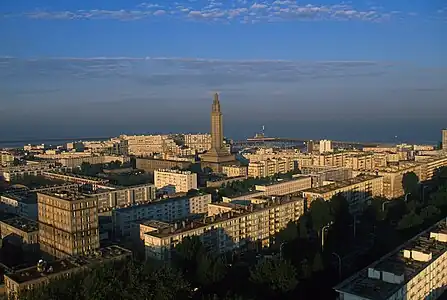Seine-Maritime | |
|---|---|
 Prefecture building of the Seine-Maritime department, in Rouen | |
 Flag  Coat of arms | |
 Location of Seine-Maritime in France | |
| Coordinates: 49°40′N 0°50′E / 49.667°N 0.833°E | |
| Country | France |
| Region | Normandy |
| Prefecture | Rouen |
| Subprefectures | Dieppe Le Havre |
| Government | |
| • President of the Departmental Council | Bertrand Bellanger[1] |
| Area | |
| • Total | 6,278 km2 (2,424 sq mi) |
| Population | |
| • Total | 1,255,918 |
| • Rank | 16th |
| • Density | 200/km2 (520/sq mi) |
| Time zone | UTC+1 (CET) |
| • Summer (DST) | UTC+2 (CEST) |
| ISO 3166 code | FR-76 |
| Department number | 76 |
| Arrondissements | 3 |
| Cantons | 35 |
| Communes | 708 |
| ^1 French Land Register data, which exclude estuaries, and lakes, ponds, and glaciers larger than 1 km2 | |
Seine-Maritime (French pronunciation: [sɛn maʁitim] ⓘ) is a department of France in the Normandy region of northern France. It is situated on the northern coast of France, at the mouth of the Seine, and includes the cities of Rouen and Le Havre. Until 1955 it was named Seine-Inférieure. It had a population of 1,255,633 in 2019.[3]
History
- 1790 - Creation of the Seine-Inférieure department
- The department was created from part of the old province of Normandy during the French Revolution, on 4 March 1790, through the application of a law of 22 December 1789.
- 1815 - Occupation
- After the victory at Waterloo of the coalition armies, the department was occupied by British forces from June 1815 till November 1818.
- 1843 – Railways and industry
- In Rouen, Elbeuf, and Bolbec, the number of textile factories is increasing. Metallurgy and naval construction as well.
- 1851 - A republican department
- Following President Louis-Napoléon Bonaparte's 1851 Coup d'état, Seine-Inférieure was one of several departments placed under a state of emergency (literally, in French, state of siege) [4] following fears of significant resistance to the new government.
- World War II
- In 1942, during occupation by Nazi Germany, two Allied raids, the Bruneval and Dieppe, took place at towns of the channel coast of Seine-Inférieure.
- 1955 - Rename to Seine-Maritime
In 1955, the department's name was officially changed to Seine-Maritime.
Heraldry
 |
The arms of the departement Seine-Maritime are blazoned : Gules a fess wavy argent between two lions passant gardant or armed and langued azure.
|
Geography
The department can be split into three main areas:[5]
- The Seine valley. The Seine flows through the provincial capital Rouen.
- The chalk plateau Pays de Caux, with its abrupt coastline (the Alabaster Coast).
- The Norman Pays de Bray, with its hills and bocage landscape.
Administration
The département was created in 1790 as Seine-Inférieure, one of five departements that replaced the former province of Normandy. In 1800 five arrondissements were created within the département, namely Rouen, Le Havre, Dieppe, Neufchatel and Yvetot, although the latter two were disbanded in 1926. On 18 January 1955 the name of the département was changed to Seine-Maritime, in order to provide a more positive-sounding name and in-keeping with changes made in a number of other French departements.
Principal towns
The most populous commune is Le Havre; the prefecture Rouen is the second-most populous. As of 2019, there are 7 communes with more than 20,000 inhabitants:[3]
| Commune | Population (2019) |
|---|---|
| Le Havre | 168,290 |
| Rouen | 112,321 |
| Sotteville-lès-Rouen | 29,068 |
| Saint-Étienne-du-Rouvray | 28,352 |
| Dieppe | 28,241 |
| Le Grand-Quevilly | 25,963 |
| Le Petit-Quevilly | 22,000 |
Demographics
|
| |||||||||||||||||||||||||||||||||||||||||||||||||||||||||||||||||||||||||||||||||
| source:[6][7] | ||||||||||||||||||||||||||||||||||||||||||||||||||||||||||||||||||||||||||||||||||
Previously lacking a demonym, the inhabitants of Seine-Maritime (as the department had been renamed in 1955) chose, following a public consultation, to be identified in official documents as "Seinomarins" [8] (males) and "Seinomarines" (females).
Politics
The president of the Departmental Council is Bertrand Bellanger, elected in 2019.
Presidential elections 2nd round
| Election | Winning Candidate | Party | % | 2nd Place Candidate | Party | % | |
|---|---|---|---|---|---|---|---|
| 2022 | Emmanuel Macron | LREM | 55.28 | Marine Le Pen | FN | 44.72 | |
| 2017[9] | Emmanuel Macron | LREM | 60.42 | Marine Le Pen | FN | 39.58 | |
| 2012 | François Hollande | PS | 54.94 | Nicolas Sarkozy | UMP | 45.06 | |
| 2007 | Nicolas Sarkozy | UMP | 50.20 | Ségolène Royal | PS | 49.80 | |
| 2002[9] | Jacques Chirac | RPR | 82.58 | Jean-Marie Le Pen | FN | 17.42 | |
Current National Assembly Representatives
Transport
In 1843 the railway from Paris reached the region. The département is connected to the adjacent Eure department via the Tancarville and Pont de Normandie bridge crossings of the Seine.
Culture
Madame Bovary by Gustave Flaubert is set in Seine Maritime.
The novel La Place by Annie Ernaux largely takes place in Seine-Maritime and describes events and changes that take place in relation to French society in the 20th century especially in relation to the rural population.
The first story of the long-running series Valérian and Laureline is set in Seine-Maritime, with the character Laureline originating from the area.
Cauchois is the dialect of the Pays de Caux, and is one of the most vibrant forms of the Norman language beyond Cotentinais.
Tourism
 Notre-Dame of Rouen
Notre-Dame of Rouen_0018.JPG.webp) Element of the Atlantic Wall near Fécamp
Element of the Atlantic Wall near Fécamp
 Limestone cliffs of Étretat
Limestone cliffs of Étretat
See also
References
- ↑ "Répertoire national des élus: les conseillers départementaux". data.gouv.fr, Plateforme ouverte des données publiques françaises (in French). 4 May 2022.
- ↑ "Téléchargement du fichier d'ensemble des populations légales en 2021". The National Institute of Statistics and Economic Studies. 28 December 2023.
- 1 2 Populations légales 2019: 76 Seine-Maritime, INSEE
- ↑ Jacques Olivier Boudon, Les Bonaparte : regards sur la France impériale. La Documentation photographique, dossier 8073, janvier-février 2010, p. 11 (carte de Gilles Pécout)
- ↑ "Seine Maritime". France-For-Visitors.com. Rough Guides. Retrieved 22 October 2011.
- ↑ "Historique de la Seine-Maritime". Le SPLAF.
- ↑ "Évolution et structure de la population en 2016". INSEE.
- ↑ "Seinomarins, un beau nom !". Commune76.
- 1 2 l'Intérieur, Ministère de. "Présidentielles". interieur.gouv.fr.
- ↑ Nationale, Assemblée. "Assemblée nationale ~ Les députés, le vote de la loi, le Parlement français". Assemblée nationale.
External links
- (in French) Departmental Council website
- (in French) Prefecture website
- (in French) Communes 76